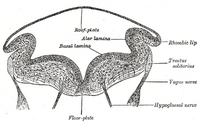
Photo from wikipedia
The body and brain are in constant two‐way communication. Driving this communication is a region in the lower brainstem: the dorsal vagal complex. Within the dorsal vagal complex, the caudal… Click to show full abstract
The body and brain are in constant two‐way communication. Driving this communication is a region in the lower brainstem: the dorsal vagal complex. Within the dorsal vagal complex, the caudal nucleus of the solitary tract (cNTS) is a major first stop for incoming information from the body to the brain carried by the vagus nerve. The anatomy of this region makes it ideally positioned to respond to signals of change in both emotional and bodily states. In turn, the cNTS controls the activity of regions throughout the brain that are involved in the control of both behaviour and physiology. This review is intended to help anyone with an interest in the cNTS. First, I provide an overview of the architecture of the cNTS and outline the wide range of neurotransmitters expressed in subsets of neurons in the cNTS. Next, in detail, I discuss the known inputs and outputs of the cNTS and briefly highlight what is known regarding the neurochemical makeup and function of those connections. Then, I discuss one group of cNTS neurons: glucagon‐like peptide‐1 (GLP‐1)‐expressing neurons. GLP‐1 neurons serve as a good example of a group of cNTS neurons, which receive input from varied sources and have the ability to modulate both behaviour and physiology. Finally, I consider what we might learn about other cNTS neurons from our study of GLP‐1 neurons and why it is important to remember that the manipulation of molecularly defined subsets of cNTS neurons is likely to affect physiology and behaviours beyond those monitored in individual experiments.
Journal Title: Journal of Neuroendocrinology
Year Published: 2022
Link to full text (if available)
Share on Social Media: Sign Up to like & get
recommendations!